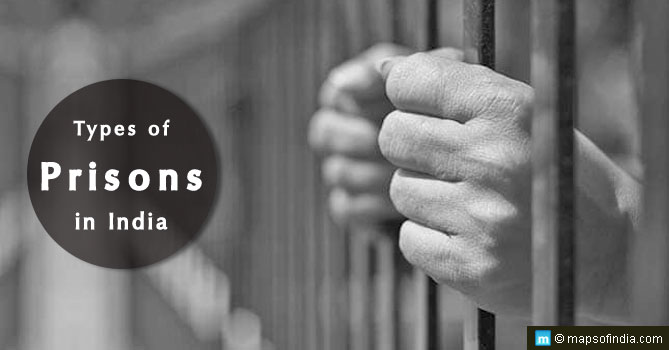
Prisons are the centres for reforming the criminals but the common notion regarding them is that they are a means of punishment. However, prisons are basically correction centres. They are governed by the Prisons Act, 1894 and the Prison manuals of the state governments. The management of prisons also falls under the domain of the state governments which with the assistance of the Central Government work for the improvement of security, living conditions, medical facilities, infrastructure and internal development of the prisons. The administration of the prisons in India is covered by item 4 under the State List in the Seventh Schedule of the Constitution of India. There are 8 kinds of prisons in India.
Read more to know about the types of prisons in India:
Central Jails – Central Jails comprises of those prisoners who are sentenced to imprisonment for more than 2 years. They are meant for lifers and for people who commit heinous crimes. In this type of prison, effort is made to restore the morality and integrity of a person. The criminals earn their wages in these types of jails. Central jails have a larger capacity of providing accommodation to prisoners in comparison to other jails. Madhya Pradesh has the highest number of Central Jails which stands at 11. Maharashtra, Rajasthan, Tamil Nadu, and Punjab have 9 central jails followed by Karnataka and Delhi which have 8. States like Arunachal Pradesh and Meghalaya do not have any Central Jails. As per the National Records Crime Bureau, there are a total of 134 central jails in India which have a capacity of accommodating 1,59,158 prisoners. As per the data of 2015, 1,85,182 inmates are present in the central jails.
District Jails – There is not much difference between the district jails and the central jails. District jails serve as main jails in those states and Union Territories of India where there are no central jails. There are a total of 379 district jails in India which have a capacity of accommodating 137972 inmates only, but currently, there are 180893 inmates present in the district jails all over India. Some states which have a considerable number of district jails include – Uttar Pradesh – 57, Madhya Pradesh -39, Bihar – 31, and Maharashtra which has 28 district jails.
Sub Jails – Sub Jails in India play the role of sub-divisional level jails in India. As they are at a lower formation, they have a better and well-organised prison set-up. There are 9 states which have a higher number of sub-jails in comparison to other states in India. Maharashtra has the highest number of sub-jails i,e 100 followed by Andhra Pradesh which has 99. Tamil Nadu has 96, Odisha -73, Madhya Pradesh – 72, Karnataka -70, and Rajasthan has 60. Some states and Union Territories do not have sub-jails. They are Arunachal Pradesh, Chandigarh, Delhi, Haryana, Manipur, Meghalaya, Mizoram, Nagaland, and Sikkim. There are a total of 741 sub-jails with a capacity of 46368 people. But currently 39989 inmates are lodged in these jails.
Women Jails – As per the latest prison analytics available in the reports of NCRB, women constitute nearly 4.3% of the total prisoners in India which is around 17, 834 women. In order to ensure the safety of women, separate jails are built exclusively for women to house female prisoners. These jails comprise of women staff. There are a total of 14 women jails in the country which has a capacity of accommodating 4748 prisoners. As per the NCRB data of 2015, there are 2985 inmates in women jails throughout the country.
Open Jails – The name of these types of jails may appear paradoxical but yes this is true. Open jails are the ones which have the minimum security. As per the definition of Rajasthan prison rules, open jails are the prisons without walls, bars, and locks. The prisoners in such type of jails are engaged in activities like agriculture and are permitted to earn for their families. Only those prisoners are admitted in the open prisons who satisfy certain norms prescribed in the prison. The prisoners of open prisons are considered to possess good behaviour. There are seventeen states in India which have 63 open jails which have a capacity to accommodate 5370 prisoners. Currently, 3789 inmates are lodged in such type of jails. P. T. Chacko, the then Home Minister of Kerala on August 28, 1962, introduced the first open jail in India in Nettukaltheri (near Trivandrum). The Supreme Court of India in December 2017 directed the centre to set up more open prisons in India.
Borstal Schools – Borstal is a type of youth detention centre. They are commonly known as Borstal schools in India. These types of prisons are exclusively used for the imprisonment of the juveniles or the minors. Basically, these schools strive to ensure the welfare, care, and rehabilitation of young offenders. They are kept away from the environment of prison. Juveniles in the borstal schools are imparted various kinds of education and vocational trainings. Emphasis is given on education and training in the borstal schools. Also, the prevention of crime is the prime focus of such schools. There are only nine states in India namely Himachal Pradesh, Jharkhand, Karnataka, Kerala, Maharashtra, Punjab, Rajasthan, Tamil Nadu, and Telangana which have such schools. There are no borstal schools in any of the Union Territories of India.
Special Jails – Special jails are the ones in which there is high security and special arrangements are made for people convicted for violent crimes including terrorism and insurgency. There are a total of 43 special jails in India which have a capacity of accommodating 10915 prisoners. Kerala has 16 special jails which is the highest number of special jails in any state in India. Provision for keeping female prisoners is also available in special jails in states including Assam, Gujarat, Kerala, Maharashtra, Tamil Nadu, and West Bengal.
Other Jails – There are only three other jails in India – Karnataka, Kerala, and Maharashtra. No state in India except these three have other jails in India.
Prisons should help in reforming humans instead of only punishing them. Reforms can be brought in society only when the criminals will be given the right chances for improvement.





